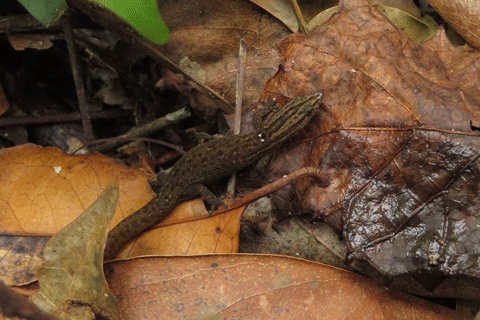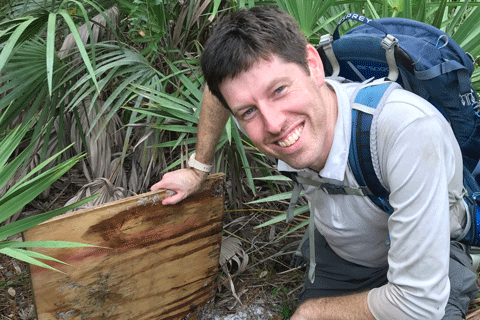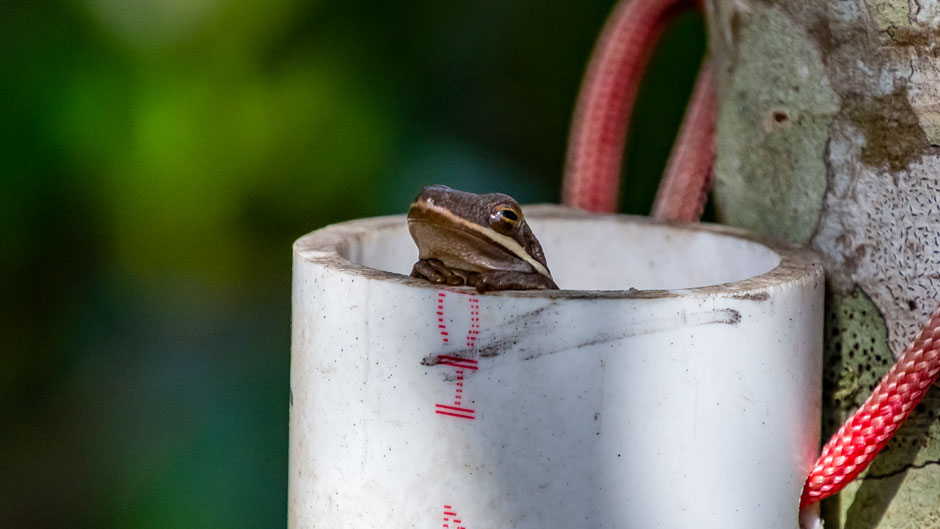With temperatures and sea level rising across the globe, University of Miami assistant professor of biology Chris Searcy is examining how these impacts are affecting reptiles and amphibians.
Searcy is spearheading research projects in South Florida and in California to determine how a range of wildlife is adapting to our changing climate, and what that might foretell about ecosystems across the globe.
Just over an hour north of campus, Searcy and graduate student Hunter Howell are measuring how different water levels in the Florida Everglades can affect the reptiles and amphibians living there. They are doing their research in the 80-acre Loxahatchee Impoundment Landscape Assessment (LILA), an experimental area at the edge of the Everglades just west of Boynton Beach. It is divided into four, 20-acre cells separated by levees. While two of the areas are exposed to more restrictive water conditions, the other two follow more natural rainfall conditions.

“We are trying out two different water management practices to see how the Everglades community responds to it,” Searcy said. “And in the first year, we are seeing that each condition has a very different impact on amphibians and reptiles."
After more than a year of field research—where Howell and a team of biology students collected more than 4,000 reptiles and amphibians—Searcy said they have learned that drier conditions foster an increase in invasive species, such as Cuban tree frogs and brown anoles (small lizards commonly found in Miami), while a less restrictive (more natural) water treatment plan is more amenable to native species.
“We were surprised that we were able to document a significant change in the composition of the [wildlife] community within the span of one year,” Howell said. “It suggests that there is a pretty strong response to water management.”
Searcy and Howell are examining the four cells quarterly for more than two years, as part of the South Florida Water Management District’s effort to improve water flow in the Everglades, mandated by the Comprehensive Everglades Restoration Plan.
Passed in 2000, the $10.5 billion federal plan aims to improve water flow throughout the region by 2035. Its goal is to also repair the Everglades ecosystem that was badly damaged by federal efforts to drain the river of grass in the 1960s to boost the amount of farmable land in Florida. But as a result, the iconic wading birds and other species native to the region began disappearing from the Everglades starting in the 1970s. According to Searcy, scientists are working to test hydrology strategies at LILA that may encourage a resurgence of native birds and animals in the Everglades.
Searcy expects that data in the next year will show an even higher number of invasive species in the drier cells, but how that surge may affect the overall Everglades ecosystem is still unclear.
“Natural food webs are very complex, and it’s hard to predict the cascading effect of these [invasive species] outcompeting the native species. But any time you perturb the preexisting elements, you’re at risk of something bad happening,” Searcy added. “It might not be something that will affect humans, but it very well could be.”
HUNTING THROUGH THE HAMMOCKS
Another species being impacted by climate change is the elusive and tiny Florida Reef Gecko, the only type of gecko native to the eastern United States.

Searcy and graduate students Stephanie Clements, Emily Powell, and Caitlin Mothes are tracking how sea level rise is impacting the existence of this gecko, which is only found in the tropical hardwood hammocks of South Florida. Hardwood hammocks are typical
ly found very close to the coast and are a few meters above sea level. Searcy pointed out that in tracking the reef geckos at 57 different sites, they have learned that the species is more threatened by sea level rise than any other reptile or amphibian species in the U.S.
“The Florida Reef Gecko is a very unique part of our local fauna and it’s clearly vulnerable to sea level rise because its natural habitat is disappearing,” he said about the geckos, which only grow to about two inches in length. “We learned that reef geckos are now absent from a third of the sites where they used to be found.”
DIRECTLY IMPACTED BY DROUGHT
Farther from campus, Searcy is also investigating the survival of another amphibian species called the California Tiger Salamander. Native to central California, they only breed in temporary ponds called vernal pools during the rainy season (winter through spring). Therefore, the entire species’ existence depends on rainfall, Searcy reported, and with climate change alternating precipitation patterns in California, there is a chance this salamander could become extinct.
“They are the top predator in vernal pools,” Searcy said. “So, they clearly play an important role in that community, and if they are not there, the entire ecosystem changes.”

Because the California Tiger Salamander is extremely threatened (it is now on the Endangered Species List), Searcy developed a mathematical model to predict when its populations will increase or decrease based on climate change, rainfall, and historical population data. He recently received an award from the U.S. Fish and Wildlife Service recognizing his efforts to help conserve the species.
“We now understand the demographics of this species better than any other amphibian,” he said, adding that he is in the process of trying to improve the model further.

